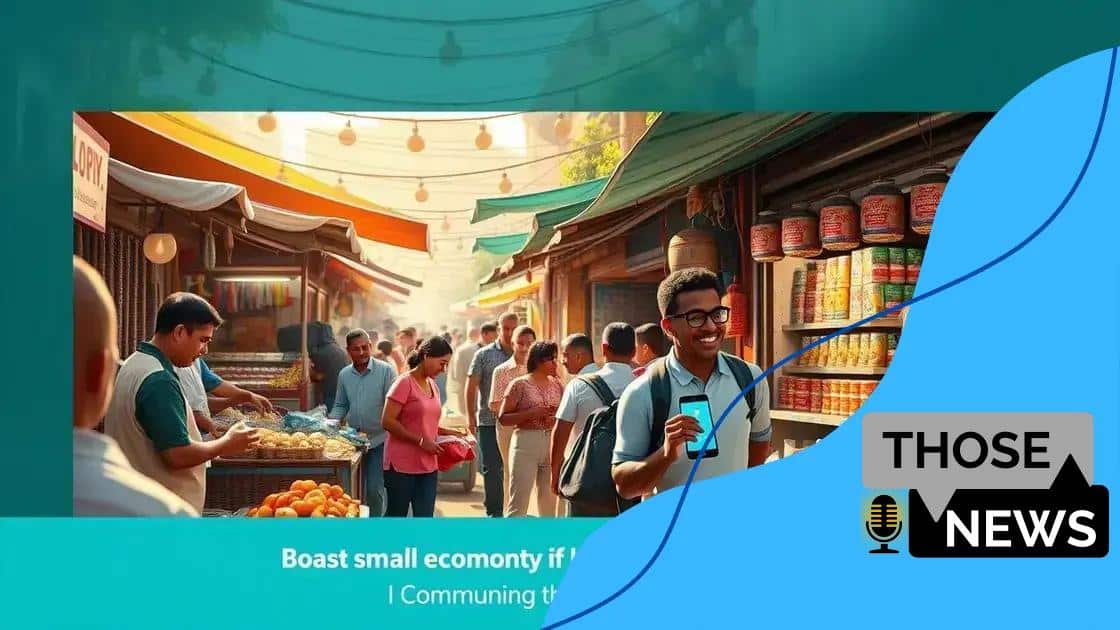Mobile payment solutions in developing countries

Mobile payment solutions in developing countries enhance financial inclusion, boost local economies, and promote secure transactions through innovative technologies like M-Pesa, GCash, and Paytm, ultimately transforming how people access financial services.
Mobile payment solutions in developing countries are changing the way people handle transactions, making financial services more accessible. Have you ever wondered how these innovations could impact daily life? Let’s dive in!
Understanding mobile payment solutions
Understanding mobile payment solutions is essential in today’s digital world. These solutions allow users to make transactions using their smartphones, making payments easy and convenient. Have you ever thought about how this technology impacts everyday life?
Many people find mobile payment solutions to be helpful. They reduce the need to carry cash and can process payments in just seconds. However, understanding the ins and outs of these systems is crucial for successful usage.
How Do Mobile Payment Solutions Work?
Mobile payment solutions generally function using near-field communication (NFC) or QR codes. The user simply taps their phone on a payment terminal or scans a code to complete the transaction.
- Secure transactions through encryption
- Instant processing and confirmation
- Supports various payment methods, from credit cards to digital wallets
Besides convenience, mobile payment solutions also offer enhanced security features. Many systems use biometric methods, such as fingerprints or facial recognition, to ensure only authorized users can access their accounts.
Benefits of Using Mobile Payment Solutions
The rise of mobile payment solutions in developing countries presents several advantages. Accessibility plays a key role in this transformation, as more people can participate in the financial system. Mobile payments are often easier to use than traditional banking, especially in areas with limited bank branches.
- Promotes financial inclusion for the unbanked
- Encourages local businesses to accept digital payments
- Speeds up transactions, benefiting both consumers and merchants
As we explore these features, we see that the use of mobile payment solutions is not only a trend but a necessity for many.”
Challenges faced in developing countries
The challenges faced in developing countries regarding mobile payment solutions can be significant. Despite the advantages of these systems, various obstacles hinder their growth and effectiveness. Informing ourselves about these challenges is essential in understanding how to overcome them.
Lack of Infrastructure
One major issue is the lack of proper infrastructure. Many regions still struggle with unreliable internet connectivity and insufficient power supply. Without a stable network connection, mobile payment solutions cannot operate efficiently.
- Limited access to reliable internet
- Frequent power outages affecting transactional capabilities
- Inadequate network coverage in rural areas
This lack of infrastructure makes it tough for users to trust and adopt mobile payment solutions. Addressing these issues is crucial for the success of digital payments in these markets.
Low Financial Literacy
Another significant barrier is low financial literacy among the population. Many individuals are unfamiliar with how these systems work, which leads to hesitance in adoption. Without proper education on using mobile payment solutions, the potential benefits may go untapped.
- Need for educational programs on digital finance
- Promoting awareness of benefits and safety
- Engaging local communities in learning initiatives
Additionally, cultural attitudes towards money and technology play a role in shaping user behavior. Overcoming skepticism is necessary for increasing the uptake of mobile payment solutions.
Regulatory Challenges
Regulatory issues can also slow the adoption of mobile payments. Different countries have varying laws around digital transactions, making it difficult for businesses to navigate. Clear and supportive regulations are essential for fostering growth.
- Inconsistent laws across regions
- Compliance costs for small businesses
- Slow response to technological advancements
By addressing these regulatory hurdles, it becomes easier for mobile payment solutions to flourish in developing countries. Stakeholders must work together to create a conducive environment for growth.
Impact on local economies

The impact of mobile payment solutions on local economies is profound and multifaceted. As these systems become more prevalent, they create various opportunities for both consumers and businesses. Understanding these impacts is key to recognizing the shift in economic dynamics.
Boosting Small Businesses
Mobile payment solutions empower small businesses to thrive. With easy access to digital transactions, local merchants can serve customers more efficiently. This accessibility often leads to an increase in sales and customer satisfaction.
- Faster transactions mean shorter wait times.
- Ability to reach a broader customer base.
- Increased trust from consumers who prefer cashless options.
Moreover, small businesses can benefit from lower operational costs associated with handling cash. When transactions are digital, the risks of theft or loss decrease significantly, creating a more secure environment for entrepreneurs.
Encouraging Financial Inclusion
Another important aspect is financial inclusion. Mobile payment solutions offer unbanked populations a chance to participate in the economy. Many people without access to traditional banking systems can now make transactions easily.
- Access to savings tools and microloans through mobile platforms.
- Reduced reliance on informal money lenders with high-interest rates.
- A pathway to improving personal finances and business opportunities.
This shift not only uplifts individual lives but also strengthens the overall economy. As more people engage in commerce, the local economy experiences growth, promoting a healthier economic environment.
Stimulating Local Employment
As businesses flourish due to mobile payment solutions, there is a natural increase in demand for labor. This situation helps stimulate local employment. New jobs mean more spending power for residents, which in turn supports further economic activity.
- Creation of jobs in tech and customer service sectors.
- Increased tourism as merchants cater to digital trends.
- Local investments in infrastructure supporting mobile networks.
Overall, the ripple effects of adopting mobile payment solutions create a vibrant economic landscape that benefits all layers of society. Stakeholders must recognize these advantages to leverage opportunities for sustainable growth.
Case studies of successful implementations
Case studies of successful implementations of mobile payment solutions provide valuable insights into how these systems can transform economies. By examining real-world examples, we can identify best practices and the positive impact on communities.
Case Study 1: M-Pesa in Kenya
M-Pesa is one of the most well-known mobile payment solutions globally, revolutionizing financial transactions in Kenya. With millions of users, M-Pesa allows individuals to send money, pay bills, and access savings accounts directly from their mobile phones.
- Enhanced financial inclusion for remote populations.
- Enabled small businesses to thrive through easy transactions.
- Reduced the need for cash handling and increased security.
The success of M-Pesa has set a precedent, inspiring similar platforms in other countries.
Case Study 2: GCash in the Philippines
In the Philippines, GCash has made waves by allowing users to pay bills, transfer money, and shop online using their mobile devices. The platform has become crucial for daily life, particularly during the pandemic.
- Encouraged contactless payments for health safety.
- Expanded access to financial services for the unbanked.
- Provided nationwide promotions that boosted local businesses.
GCash has shown how adapting to users’ needs can lead to widespread acceptance and usage.
Case Study 3: Paytm in India
Paytm is another prominent example of a successful mobile payment implementation in India. It has transformed how people make payments, purchase tickets, and pay for groceries.
- Integrated payment solutions into various sectors, including retail and transportation.
- Promoted an entire ecosystem of merchants accepting digital payments.
- Supported government initiatives to encourage cashless transactions.
By creating a user-friendly interface and expanding merchant networks, Paytm has achieved significant market penetration.
These case studies illustrate that mobile payment solutions can lead to increased financial security, greater accessibility, and a boost in local economies. By learning from these successes, other regions can adopt strategies that meet their unique needs.
Future of mobile payments in emerging markets
The future of mobile payments in emerging markets looks promising. As technology continues to advance, these regions are poised to experience rapid growth in digital transactions. Understanding what lies ahead can help stakeholders adapt to this evolving landscape.
Increasing Smartphone Penetration
One major factor driving the future of mobile payments is the increasing penetration of smartphones. More people now own smartphones than ever before, providing greater access to mobile payment solutions.
- Affordable smartphone models are entering the market.
- Increased internet connectivity boosts usability.
- Younger populations are embracing technology quickly.
This trend not only fosters convenience but also offers financial services to previously unbanked populations.
Innovative Payment Solutions
Innovation in payment technologies is another key element shaping the future. As businesses strive to meet customer needs, new solutions will arise. For instance, contactless payments and integration with other digital services are becoming commonplace.
- Emerging fintech companies are launching unique mobile payment applications.
- Local solutions are tailored to cultural preferences and needs.
- Blockchain technology may play a role in enhancing security and transparency.
These innovations will empower consumers and create a competitive environment for businesses.
Increased Government Support
Government support will also play a crucial role in shaping the landscape of mobile payments. Many governments are actively promoting digital financial inclusion through favorable regulations and initiatives. This shift will enhance trust in mobile payment systems.
- Programs to educate citizens about digital finance.
- Policies encouraging entrepreneurship in the fintech sector.
- Partnerships between governments and tech companies to improve infrastructure.
As governments commit to improving access and security, the adoption of mobile payment solutions will likely accelerate.
Overall, the future of mobile payments in emerging markets promises to deliver greater financial inclusion, improved technology, and innovative solutions. Stakeholders must stay informed to harness the potential of these changes effectively.
The rise of mobile payment solutions in developing countries is reshaping financial landscapes. These innovations enhance financial inclusion, allowing unbanked populations to access essential services. As we’ve seen through successful implementations in countries like Kenya, the Philippines, and India, mobile payments provide increased convenience and security for users. Moving forward, evolving technologies, greater smartphone penetration, and supportive government policies will drive further growth. The future appears bright for mobile payments, and embracing these changes will be beneficial for businesses and individuals alike.
FAQ – Frequently Asked Questions about Mobile Payment Solutions in Developing Countries
How do mobile payment solutions improve financial inclusion?
Mobile payment solutions allow unbanked individuals to access essential financial services, empowering them to participate in the economy.
What are some successful examples of mobile payment implementations?
Notable examples include M-Pesa in Kenya, GCash in the Philippines, and Paytm in India, all of which have increased access to finance.
What role do government policies play in mobile payments?
Supportive government policies can promote digital financial services, creating a more secure and accessible environment for mobile payments.
What future trends can we expect in mobile payments?
We can expect increased smartphone penetration, innovative technologies, and a rise in government support to drive the growth of mobile payment solutions.





